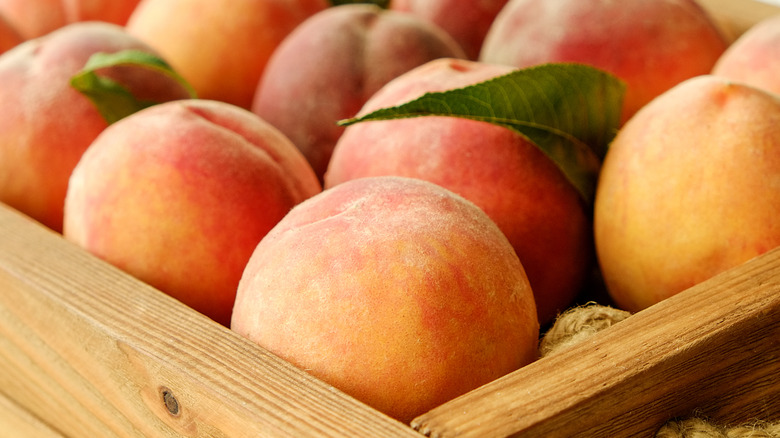The Best Type Of Peach For Versatile Cooking
While there are several different types of peaches available on the market, none are more versatile from a cooking perspective than freestone peaches. Being part of the most well-known and highly produced of all stone fruits, freestone peaches are one of the three main categories of peaches, the other two being clingstone and semi-freestone. As the name suggests, the stone — the large seed at the center of the fruit — in a freestone peach is not attached to the interior flesh. In contrast, the stone of a clingstone peach clings onto the fruit flesh like super glue.
When working with peaches for a recipe, you're usually required to cut them into certain shapes in order for the fruit incorporate well into the dish. This is easy with a freestone peach. You can cut through the flesh of the peach and remove the stone with your fingers. Since it's not connected to the flesh, the removal of the stone won't affect the physical structure of the peach. Therefore, with the pit removed, you have the freedom and flexibility to cut the peach any way you'd like. Their firmer texture also means that they will better retain their shape when sliced.
Freestone peaches, such as the white-fleshed Babcock or heirloom Belle of Georgia, are readily available at most grocery stores, making them convenient for the average buyer who may not have access to a local orchard. They are excellent for eating fresh or for baking, canning, and freezing.
Cooking with freestone peaches
Freestone peaches are characterized by their firm, not overly juicy texture, and their sweet flavor. They come in either white or yellow flesh varieties and are typically harvested starting in May and lasting through October. This gives them a wide range of uses across multiple different seasons. In summer, you could whip up a classic peach cobbler served alongside heavy dollops of refreshing vanilla ice cream. If you don't feel like heating up your kitchen, simply add some sliced peaches with a bowl of ice cream, or add them to some refreshing lemonade or sangria.
In the fall, freestone peaches can do any number of bakes, such as cobblers, crisps, or pies. Fall is also an excellent time for canning. Freestone peaches are great to can because they will retain their structural integrity and have flesh that is resistant to browning. Therefore, you could make beautiful jars of sliced peaches that you can save to use at a later date for ice creams, compote, or syrup. Freestone peaches are also a great option for freezing.
There really is no limit when it comes to what you can do with peaches. They have an excellent flavor that translates across a variety of different dishes. It's the versatility of freestone peaches put them at the top of the heap, however. All around, they are an easy, flavorful, convenient, and sturdy peach category that you'd do well to keep in your kitchen.

